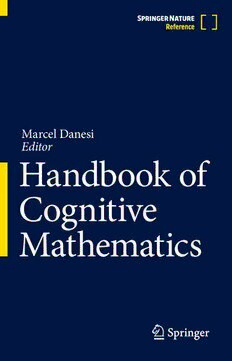
Handbook of Cognitive Mathematics PDF
Preview Handbook of Cognitive Mathematics
Marcel Danesi Editor Handbook of Cognitive Mathematics Handbook of Cognitive Mathematics Marcel Danesi Editor Handbook of Cognitive Mathematics With264Figuresand34Tables Editor MarcelDanesi Anthropology,VictoriaCollege UniversityofToronto Toronto,ON,Canada ISBN978-3-031-03944-7 ISBN978-3-031-03945-4(eBook) https://doi.org/10.1007/978-3-031-03945-4 ©SpringerNatureSwitzerlandAG2022 Thisworkissubjecttocopyright.AllrightsarereservedbythePublisher,whetherthewholeorpartofthe materialisconcerned,specificallytherightsoftranslation,reprinting,reuseofillustrations,recitation, broadcasting,reproductiononmicrofilmsorinanyotherphysicalway,andtransmissionorinformation storageandretrieval,electronicadaptation,computersoftware,orbysimilarordissimilarmethodology nowknownorhereafterdeveloped. Theuseofgeneraldescriptivenames,registerednames,trademarks,servicemarks,etc.inthispublication doesnotimply,evenintheabsenceofaspecificstatement,thatsuchnamesareexemptfromtherelevant protectivelawsandregulationsandthereforefreeforgeneraluse. Thepublisher,theauthors,andtheeditorsaresafetoassumethattheadviceandinformationinthisbook arebelievedtobetrueandaccurateatthedateofpublication.Neitherthepublishernortheauthorsorthe editorsgiveawarranty,expressedorimplied,withrespecttothematerialcontainedhereinorforanyerrors oromissionsthatmayhavebeenmade.Thepublisherremainsneutralwithregardtojurisdictionalclaims inpublishedmapsandinstitutionalaffiliations. ThisSpringerimprintispublishedbytheregisteredcompanySpringerNatureSwitzerlandAG. Theregisteredcompanyaddressis:Gewerbestrasse11,6330Cham,Switzerland. Preface Mathematicsisbothacreationanddiscoveryofthehumanmind.Researchhasbeen showing that mathematical discoveries in general seem to be located in the same neural circuitry that sustains ordinary language and other symbol systems. Mathe- matics makes sense when it has meanings that fit our cognitive experiences of the world – experiences of quantity, space, motion, force, change, mass, shape, proba- bility, self-regulating processes, and so on. The inspiration for new mathematics comes from these experiences. Studying the relation between cognition and math- ematicscomesunderageneralrubric–whichcanbecalledthecognitivescienceof mathematics,orcognitivemathematicsforshort. This handbook is intended as a reference volume for cognitive mathematics, whichcanbedefinedmoreconcretelyasthestudyoftherelationofmathematicsto other human faculties, from the arts to language. This is of interest to diverse disciplines, spanning education to computer modeling. Therefore, this handbook includesthebackgroundworkinthefieldandsectionsdealingwiththeinterconnec- tionsbetweenmathematicsandotherfaculties.Thechaptersarewrittenbyinterna- tionallyrenownedauthorswhoareauthoritiesintheirfields.Anoveralldiscussionof thevolume’sfocusandareascoveredisprovidedintheintroductiontothehandbook. In contemporary academia, the question of what is mathematics and how it is learnedhasbeenaddressedthroughavarietyofmethodsinabroadsetofdisciplines. Building on some of the developments in the different fields, the chapters in this volume,whenconsideredcumulatively,discusshowmathematicsinvolvesablend of imagination, abstraction, and notation-making processes – all of which have profound implications for the teaching and learning of mathematics. In his 2008 collectionofstudiesonmathematicalcognition(MathematicalCognition,Charlotte: InformationAgePublishing),JamesRoyerpointedoutthatthestudyofmathemat- ical cognition spanned a broad field of scientific, educational, and humanistic interests.Theverityofthisobservationisbeingconstantlyevidencedinthestudies published in diverse journals, which show the truly wide range of approaches to mathematics cognition, bringing together researchers from diverse fields to cast shreds of light on this truly fascinating phenomenon from different angles. The main implication that can be drawn from looking over works in the field is that mathematics cognition cannotbestudied withinthe confinesofa single discipline. The main focus seems to be discerning and explaining the neural basis of v vi Preface mathematics. This handbook aims to cast a wide net to the study of mathematical cognition,bringing together scientists and humanists,so astoenlargethepurview. Whilethescientificstudyisfundamentallyempirical,theadditionofmorehuman- istic disciplines to the mix allows the field to enter into more theoretical and speculative domains, thus perhaps both opening up a debate that is not based on empiricalissuesalonebutonamorespeculativeground–thusmirroringtheorigins ofmathematicsinphilosophy. The study of mathematical cognition really took off after the publication of Lakoff and Núñez’s controversial 2000 book, Where Mathematics Comes From, which argued that mathematics is essentially no different from language or other symbol systems, since both share a basic modality – blending information from differentpartsofthebraintoproducenovelinformation.Onesimpleverificationof thisisthefactthatweuselanguagetolearnmathematicsandthatmathematicshas many structural properties that are linguistic. The most salient manifestation of blending can be seen in metaphor, which undergirds how we think and learn. The questionthatLakoffandNúñezaskedwashowmetaphoricalprocessesallowusto understandcomplexconceptssuchasinfinityandlimits.Ifmetaphorisindeedatthe coreofmathematicalreasoning,thenitbringsmathematicsdirectlyintothesphereof culture where it is shaped symbolically and textually. Whatever the truth, it is obvious that the study of mathematical cognition will benefit significantly by the participation of humanists and mathematicians in collaboration with the empirical scientists. In his groundbreaking 1962 study on the cognitive source of scientific theories, the American philosopher Max Black argued, before Lakoff and Núñez, that the genesisoftheoreticalnotionsandframeworksinthesciencesandmathematicswas not solely the result of scientists deducing them from empirical observations or experimental results, but also, and primarily, the result of scientists making infer- encesandconnectionsbetweenfacts,othertheories,andeveneverydayexperience. Indirectly,Blacklaidthefoundationsforcognitivemathematicswithhisradicalidea fortheerainwhichitwaswritten. Intheancientworld, actually, theidea thatmathematics was apart ofabroader systemofthoughtwasavirtualgiven.Thetransitionofmathematicsfromapractical counting,measuring,andgenericproblem-solvingcrafttoatheoreticaldisciplineis traced generally to the emergence of the method of proof. The chapters of this handbook span the interdisciplinary scope of cognitive mathematics, from the empirical to the educational and speculative, as well as examining aspects of mathematical methods and what they tell us about the nature of mathematical cognition. The objective here is twofold: to show how this line of inquiry can be enlargedprofitablythroughanexpandedpoolofparticipatingdisciplinesandtoshed somenewlightonmathcognitionitselffromwithinthispool. Wehopethatreaderswillfindthishandbookinformative.Webelievethatmathe- maticians,cognitivescientists,educatorsofmathematics,philosophersofmathematics, andalltheotherkindsofscholarswhoareinterestedinthenatureofmathematicswill findsomethingofinterestinthisvolume.Theimplicitclaiminallthestudiesisthatin Preface vii ordertopenetratethephenomenonofmathematics,itisnecessarytoutilizemethods andtheoreticalframeworksderivedfromavarietyofdisciplines. Toronto,Canada MarcelDanesi September2022 Contents Volume 1 SectionI MathematicsandCognition ........................ 1 DonnaE.West 1 TheCognitiveandEpistemicValueofMathematics:Making theWorldIntelligible–TheRoleofAbduction,Diagrams,and Affordances ........................................... 9 LorenzoMagnani 2 PeirceandGrothendieckonMathematicalCognition:AMerging ofthePragmaticistMaximandToposTheory ................ 49 FernandoZalamea 3 LinguisticandVisuospatialChunkingasQuantitativeConstraints onPropositionalLogic .................................. 67 DonnaE.West 4 BlendingTheoryandMathematicalCognition ............... 89 MarcelDanesi SectionII Ethnomathematics .............................. 111 MyrdeneAndersonandTodShockey 5 EthnomathematicsandCulturalIdentitytoPromoteCulturally ResponsivePedagogicalChoicesforTeachersinEarly ChildhoodandElementaryEducation ...................... 115 SandraWildfeuer 6 BundlesofEthnomathematicalExpertiseResidingwith Handicrafts,Occupations,andOtherActivitiesAcross Cultures .............................................. 129 VeronicaAlbanese ix x Contents 7 Emic,Etic,Dialogic,andLinguisticPerspectiveson Ethnomodeling ........................................ 161 MiltonRosaandDanielClarkOrey 8 EthnomathematicsinEducation:TheNeedforCultural Symmetry ............................................ 191 TamsinMeaney,TonyTrinick,andPiataAllen 9 EthnomathematicsAffirmedThroughCognitiveMathematics andAcademicAchievement:QualityMathematicsTeaching andLearningBenefits ................................... 221 JenniL.Harding SectionIII CognitiveNeuroscienceofMathematics ............ 251 RolandH.Grabner 10 DevelopmentalBrainDynamics:FromQuantityProcessingto Arithmetic ............................................ 257 StephanE.Vogel 11 NeurocognitiveFoundationsofFractionProcessing ............ 289 SilkeM.Wortha,AndreasObersteiner,andThomasDresler 12 IndividualDifferencesinMathematicalAbilitiesand Competencies ......................................... 317 SaraCaviola,IreneC.Mammarella,andDenesSzűcs 13 Mind,Brain,andMathAnxiety ........................... 349 RachelPizzie 14 NeurocognitiveInterventionstoFosterMathematical Learning ............................................. 385 KarinKucianandRoiCohenKadosh SectionIV BiologicalApproachestoMathematics ............. 413 DanVilenchik 15 TheNeurobiologicalBasisofNumericalCognition: Decision-MakingProcessesasaNewLineofInquiry .......... 415 LitalDachesCohenandOrlyRubinsten 16 TrustingYourOwnEyes:VisualConstructions,Proofs,and FallaciesinMathematics ................................. 431 MargoKondratieva Contents xi 17 NumericalAbilitiesinNonhumans:ThePerspectiveof ComparativeStudies .................................... 469 RosaRuganiandLuciaRegolin 18 ExecutiveDysfunctionAmongChildrenwithADHD: ContributionstoDeficitsinMathematics .................... 501 LaurenM.Friedman,GabrielleFabrikant-Abzug,SarahA.Orban, andSamuelJ.Eckrich SectionV MathematicsandtheArts ........................ 539 StéphanieWalshMatthews 19 TheChallengeofFormalLogicsandMetaphysicalSystemsto Semiotics ............................................. 543 EeroTarasti 20 CulturalSymmetry:FromGroupTheorytoSemiotics ......... 573 JaminPelkey 21 Fractals,Narrative,andCognition ......................... 595 RichardRosenbaum 22 VisageMathematics:SemioticIdeologiesofFacialMeasurement andCalculus .......................................... 617 MassimoLeone Volume 2 SectionVI LearningandTeachingMathematics .............. 643 DraganaMartinovic 23 TheRolesofIntelligenceandCreativityforLearning Mathematics .......................................... 647 MichaelaA.MeierandRolandH.Grabner 24 GesturesinMathematicsThinkingandLearning ............. 685 OrnellaRobutti,CristinaSabena,ChristinaKrause,CarlottaSoldano, andFerdinandoArzarello 25 TeachingandLearningAuthenticMathematics:TheCaseof Proving .............................................. 727 AndreasJ.Stylianides,KotaroKomatsu,KeithWeber,andGabrielJ. Stylianides 26 WhyAreLearningandTeachingMathematicsSoDifficult? ..... 763 AlanH.Schoenfeld
